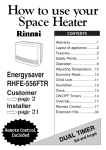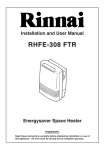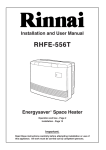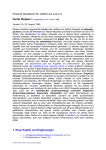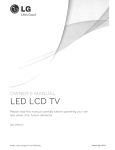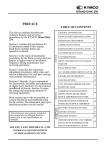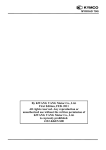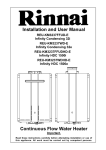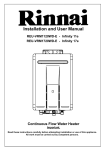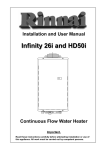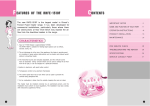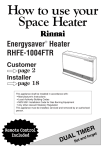Download Rinnai RHFE-1004T User manual
Transcript
Installation and User Manual RHFE-1004T Ñ Energysaver Space Heater Important. Read these instructions carefully before attempting installation or use of this appliance. All work must be carried out by competent persons. Rinnai Corporation - Japan ISO 9001 APPROVED BY JIA Manufactured under a Quality System Certified as complying with ISO 9001 by an Accredited Certification Body. CONTENTS Features of your 1004T ……………………………………………………………………………………2 Getting to know your New 1004T …………………………………………………………………………3 Control Panel Layout ………………………………………………………………………………………4 Important Points ……………………………………………………………………………………………5 Customers Operating Information How to operate the Heater …………………………………………………………………………………7 Adjusting Temperature………………………………………………………………………………………8 Economy Mode………………………………………………………………………………………………8 Function Lock ………………………………………………………………………………………………9 Other Operating Information………………………………………………………………………………10 Installation Location ……………………………………………………………………………………………………11 Installation Instructions ……………………………………………………………………………………14 Making Electrical Connection ……………………………………………………………………………15 Wiring Diagram for Programmer …………………………………………………………………………16 Summary of Position for Terminal ………………………………………………………………………17 Installation Instructions ……………………………………………………………………………………18 Using the Template ………………………………………………………………………………………19 Sleeve and Manifold Installation …………………………………………………………………………20 Fitting Unit …………………………………………………………………………………………………21 Forced Flue Heater Extension Kits ………………………………………………………………………24 Testing ………………………………………………………………………………………………………29 Gas Pressure Setting Procedure…………………………………………………………………………30 Gas Conversion Procedure ………………………………………………………………………………31 Care of your 1004T ………………………………………………………………………………………32 Pre-service Check …………………………………………………………………………………………33 Error Messages ……………………………………………………………………………………………34 Safety Devices ……………………………………………………………………………………………35 Product Specifications Dimensions …………………………………………………………………………………………………36 Wiring Diagram ……………………………………………………………………………………………37 Warranty ……………………………………………………………………………………………………38 Specifications ………………………………………………………………………………………………39 Service Contact Points ……………………………………………………………………………………39 –1– FEATURES OF YOUR 1004T Push Button Ignition: Only one touch of the ON/OFF button is required to operate the heater. 7 Step Automatic Heat Control with electronic thermostat. The fan is also controlled by the thermostat. Economy Mode: An energy saving feature that reduces the room temperature by 3˚C over a 90 minute period. Lockable Control Panel Lid: The 1004T has a lockable Control Panel Lid which is ideal for commercial use. This feature is great for applications where safety is paramount or when the unit is required to be set once and left alone. Two keys are also supplied with the unit. Function Lock: Prevents children from altering heater settings whilst running, or from activating the heater when turned off. This feature is utilised if the Control Panel Lid is unlocked. Heater Filter Indicator: When the heater filter becomes covered with dust and the temperature inside the appliance rises, the heater filter indicator will flash indicating that cleaning is necessary. The integral humidifier tray can be filled with water as required to raise the humidity level in the room. Room Sealed: Air for combustion is taken from the outside and the flue product is exhausted outside, keeping the room air clean. –2– GETTING TO KNOW YOUR NEW 1004T Filt er oN CONTROL PANEL OPERATION/TEMPERATURE CONTROL DISPLAY FILTER INDICATOR OPERATION INDICATOR WARM AIR OUTLET HUMIDIFIER OPEN THE DOOR AND POUR WATER INTO THE TRAY. GAS CONNECTION AIR FILTER 1/2" BSP (15mm) FLUE TERMINAL THERMISTOR EXHAUST PIPE POWER CORD RATING PLATE PLUG 230VAC COMBUSTION AIR INTAKE HOSE –3– MODEL NUMBER, SERIAL NUMBER, GAS TYPE, ETC. CONTROL PANEL ALL BUTTONS BEEP WHEN OPERATED. TEMPERATURE DISPLAY SHOWS EITHER THE TEMPERATURE OR CODED ERROR MESSAGES. ON/OFF BUTTON Easy operation One touch ignition 〈CONTROL PANEL〉 Set Temp Room Temp Economy Temp Control ON/OFF Function Lock ENERGY SAVING BUTTON Lamp is “green” when this feature is activated. FUNCTION LOCK Lamp is “green” when this feature is on. FILTER LAMP Flashes when filter is dirty. TEMPERATURE BUTTONS “ ” adjust temp. to lower setting. “ ” adjust temp. to a higher setting. OPERATION LAMP This lamp turns “green” when power is on. Lamp will change to “red” when burner is on. 〈INDICATOR DISPLAY〉 Filter –4– ON IMPORTANT POINTS Do not use for any other purpose except heating. These clearances should be maintained at all times. 250mm 50mm 50mm 1000mm Keep flammable materials, trees shrubs etc. away from flue terminal. Do not allow cur tains or other flammable materials to come into contact with the heater. LP GAS Flue Terminal Do not store flammable products near the unit. Supervise children near heater. Do not allow young children or the infirm to sleep directly in front of the heater. –5– IMPORTANT POINTS Don’t allow children to ‘post’ articles in the louvres. Don’t place any articles containing liquids on top of the heater. Don’t spray aerosols on the heater whilst it is in operation. Most aerosols contain butane gas and can be a fire hazard if used near this heater when in use. Do not place articles on or against the heater. Do not sit on this heater. –6– HOW TO OPERATE THE HEATER ■ Turning ON ●Press the ON/OFF button ・The ON indicator will illuminate green. ・The combustion fan will rotate. ・Ignition will take 5〜10 seconds and the ON/Combustion indicator will change from green to red to let you know that the burner has ignited. ON / OFF Note: ・When using the unit for the first time or after long periods of disuse, ignition may not occur the first time it is operated as there may be air in the gas pipes. If ignition does not occur after approximately 30 seconds the unit will cease operation automatically. Try operating the unit again if this occurs. ・The unit may make noises after ignition/extinction. This is the inside of the unit expanding and contracting and is normal. ・The heater will not ignite if the “ON/OFF” button is pressed straight after extinction. After approximately 20 seconds has passed the unit will automatically go back into ignition mode. ■ Turning OFF ●Press the ON/OFF button ・The ON/Combustion indicator will go out. ・ After the indicator has gone out, the convection fan will continue to rotate for several minutes, then stop. This is to lower the temperature within the unit. Do not pull out the power cord during this time. ON / OFF CAUTION ! ・Do not pull out the power cord or disconnect the power during combustion to cause extinction, or straight after extinction, as this may cause damage to the unit. When the Function Lock is set, the Function Lock indicator will continue to illuminate even when the unit is OFF and the Function Lock will not be cancelled. –7– ADJUSTING THE TEMPERATURE Displaying, setting and adjusting the room temperature can only be done when the heater is operating. ・When the unit is first operated, the room temperature is set at 22˚C. ・Set the desired room temperature with the up and down buttons while looking at the display section. ・The “Set Temp” can be set to “L” or between “12” 〜 “26”, or “H” (continuous combustion on High). ・The “Room Temp” will display “L” (when lower than 1˚C), “1” 〜 “30” (at intervals of 1˚C), or “H” (when higher than 30˚C). ・Once a temperature is set, it will be stored in the microcomputers memory. Set Temp Room Temp Temp ・ Time Function Lock Note: Press to lower the temperature ・Rooms may not arrive at the set temperature due to the construction of the room, the location of the unit, or external temperatures. Press to raise the temperature If the heater does not ignite then the pre-set temperature may not be set to a temperature which is higher than the actual room temperature. ECONOMY MODE The Economy Mode, when selected, has the ability to reduce gas consumption and ultimately save energy. Once a room has reached the desired temperature, the unit will automatically begin reducing the set temperature gradually. This reduction is normally not noticeable, however, it is purely your choice whether to select this mode or not. How it works ・After a room reaches the set temperature, the set room temperature will decrease 3 times automatically, each time, dropping by a maximum of 1˚C in 30 minute blocks. From the second time onwards, the comfort control will automatically operate. (The comfort control alters combustion and fan speed more frequently to counteract the feeling of cold air.) ・The Economy indicator will illuminate to let you know that the Economy Function is selected. ・The Economy function will not operate when the set room temperature is less than 16˚C or above 26˚C. ・When the Economy function is operating, the current displayed room temperature may be lower than the set room temperature, however, this is normal. Set Room Temp Max. 1℃ Max. 1℃ Max. 1℃ 30min 30min 30min Comfort Control "Economy" indicator illuminates –8– FUNCTION LOCK The Function Lock will help to prevent accidental operation as well as small children from altering the heater settings. Set Temp 1 Room Temp The Function Lock can be operated either when the heater is running, or in the “stand by” mode, by pressing the up and down buttons simultaneously. The Function Lock is activated and the Function Lock indicator will glow. Temp ・ Time Function Lock Set Temp 2 Room Temp To de-activate the Function Lock, simply press both arrow buttons simultaneously for 2 seconds and the Function Lock indicator will go out. The lock can be de-activated at any time in this way. Temp ・ Time Function Lock When the Function Lock is activated during normal operation all heater controls other than the OFF switch will be locked. Deactivating the lock releases the controls. If the lock is activated whilst the heater is turned OFF, then all heater functions will be locked. If the heater is turned OFF whilst the Function lock is activated, it cannot be turned ON again until the lock is deactivated. –9– OTHER OPERATING INFORMATION ■ HUMIDIFIER TRAY Humidifier Tray Your 1004T is fitted with an enamelled tray behind the air outlet so that you can humidify the air. To fill the tray, open the door as shown in the diagram and pour water into the tray using the spout built into the door. The air will be humidified as it passes over the water in the tray. DO NOT FILL THE TRAY WHILST THE UNIT IS IN OPERATION. CLOSE THE DOOR AFTER FILLING. The 1004T is a very high efficiency appliance. During operation a small amount of water is produced in the flue tubes. This drains into the enamel tray. It is quite normal for a small quantity of water to remain in the bottom of the tray. If you are using the humidifier, it will need filling about once a day during the peak heating season. Max. Fill Line Access Door Pull Filler Spout Do not force door open too far. Close door during heater operation. ■ FAN FILTERS Fan Filters To protect the fan from dust and lint, the 1004T is fitted with 2 fan filters. They are located at the top, rear of the unit. To clean, pull the filters out of the unit and remove dust with a soft brush or a vacuum cleaner. Re-fit filters after cleaning. Your 1004T has a filter clean warning indicator that will illuminate when required, however, weekly cleaning is recommended during the peak heating season. Filter clean warning indicator Filt er oN ■ OUTSIDE FLUE On cold days steam may be discharged from the flue outlet. This is normal with a high efficiency appliance and does not indicate any fault. The heater and its flue must be installed correctly by an authorised person, and the installation must conform to all local regulations. The installation also must comply with the instructions supplied by Rinnai. This heater must be serviced, installed and removed by an authorised person. No parts or functions should be modified or permanently removed from the heater or its flue. – 10 – LOCATION When positioning the unit the main points governing the location are: This unit is not designed to be built in. (1) Flueing (2) Warm Air Distribution. This heater must not be installed where curtains or other combustible materials could come into contact with it. In some cases curtains may need restraining. See diagram for other recommended clearances. 250mm Flue is not designed to be positioned under floors, or below the level of the heater. 50mm 50mm 1000mm Flue Terminal Flue Terminal Flue terminal should be positioned away from flammable materials. LP GAS Flue fittings must be kept clear of flammable materials. Flue Terminal – 11 – LOCATION Do not flue into natural draught flues or fireplaces, this unit can only be used with a Rinnai flue kit. (A flue kit is available to flue right through to the rear of most fireplaces Use this kit when the heater is going to be installed in front of a fireplace.) Do not flue unit into other rooms. Flue terminal must be outside. Standard Installation of flue manifold. Diagram below shows minimum clearances and distances from obstructions. Flammable 600mm Wall Non Flammable 250mm 300mm 600mm Opposite Wall Floor Side Clearances. 300mm Flue may be positioned directly under opening windows with a minimum clearance of 300mm. Obstruction Flue sizes: S A B C D E flue suits walls flue suits walls flue suits walls flue suits walls flue suits walls flue suits walls 75 115 240 400 600 800 - 115 mm 240 mm 400 mm 600 mm 800 mm 1000 mm SNOW AREAS 25mm spacers are available for wall thicknesses less than 75mm. Snow In areas subject to heavy snowfall, keep snow clear of flue terminal at all times. For information on special extra long flues, contact Rinnai UK Ltd. – 12 – LOCATION Do not install the unit in an unusually dusty area. FOR WEATHERBOARD WALLS DRILL THROUGH CENTRE OF WEATHERBOARD FROM OUTSIDE, THEN DRILL FROM INSIDE THROUGH PLASTERBOARD. (mm) 54 Use flue guard if the terminal is easily accessible to children. Check local regulations. Flue guards are available as an optional extra. 22 300 50 R2 65 R3 38 465 When drilling the flue hole, check for water and gas pipes and electric cables before starting to drill. Use an 80mm (8cm) drill for hole through wall. ;;;; ;;;; ;;;; ;;;; ;;;; ;;;; ;;;; ;;;; GUARD ¢¢¢ ;;; QQQ ;;; QQQ ¢¢¢ ;;; QQQ ¢¢¢ ;;;; ;;;; ;;;; ;;;; ;;;; ;;;; ;;;; Floor must be level. Do not use electrical extension cords to connect unit to power supply. Keep the power cord away from the flue. Flue manifold position. Centre of hole for flue manifold can be drilled anywhere within the shaded area. (To avoid studs etc.) – 13 – INSTALLATION INSTRUCTIONS Important Safety Instructions 1. Gas Safety (Installation & Use) Regulations 1998 are the ‘Rules in Force’. In your own interest and that of safety, it is law that all gas appliances shall be installed by competent persons in accordance with the above regulations. Failure to install appliances correctly could lead to prosecution. Other persons should NOT attempt to install this equipment. 2. Unpack the appliance and check it carefully. If it appears to have any operating defects DO NOT INSTALL, but contact the supplier. 3. This appliance is intended to be used to raise the temperature in a room or office etc. You should NOT use it for any other purpose without seeking advice from the supplier. 4. This appliance is safe if correctly installed and sited. Please comply CAREFULLY with the instructions. 5. This appliance is to be used for NATURAL GAS (G20) and PROPANE (G31) only. It must NOT be used with any other type of gas. 6. Installation MUST be carried out in accordance with the current issue of: a) Building Regulations issued by the Dept. of the Environment and Building Standards (Scotland Consolidation) Regulations. b) I.E.E. Wiring Regulations for electrical installations. c) Gas Safety (Installation and Use) Regulations 1998. d) BS5871 Part 1:2001 e) BS5440 Part 1:2000 and Part 2:2000 f) BS6891 Part 1:1998 (Natural Gas) and BS5482 Part 1:1994 (Propane). g) Local Byelaws h) Children & Young Persons Act 1933 revised 1952 i) Health and Safety at Work etc. Act, 1974 j) Such other specifications or legislation that may have superseded the above documents. 7. Should the heater be fitted in a room where there are young children; elderly; infirm or handicapped persons, it is strongly recommended that a guard is fixed around the heater. Guards conforming to British Standard Specification 6778:1986 (Fireguards for Use with Portable Free Standing or Wall Mounted Heating Appliances) in respect of fixing, strength and painted finish are acceptable and overall dimensions should be such that there is a gap of at least 100mm (4 inches) between the guard and the heater. Standard guards that meet these requirements are available from the supplier. Please be sure you are aware of the implications of these notes. – 14 – MAKING ELECTRICAL CONNECTION WARNING: This appliance must be earthed. This appliance is suitable for use on 230V 〜 50Hz mains only and external wiring must be carried out to I.E.E. Regulations. Connect the appliance to the mains electrical supply. A 3amp switched fuse spur with contact separation of at least 3mm on all poles, must be provided as a means of electrically isolating the heater for servicing purposes. Observe polarity and that wiring is correctly restrained. E L N EARTH LIVE NEUTRAL Green / Yellow Brown / Red Blue / Black IMPORTANT Do not use a clock or any other type of switch on the electrical supply apart from as the means of isolating the supply for servicing. (A clock or switch in the supply would also turn OFF the convection fan and allow overheating to take place). INSTALLATIONS NOT INCORPORATING A REMOTE TIMING DEVICE When the heater is to be used as a stand-alone unit the central timer sub PCB fitted on the heater has to be disconnected from the main PCB. Disconnecting terminal plug H (white, red and blue wires), as indicated on the top wiring diagram of page 37, will enable the heater to operate independent of a timing device. Plug H TIME CONTROL It is necessary to make the time control electrical connection before the unit is fixed to the wall. The switch live and neutral wires from any remote timing device must be connected onto the terminal connector situated on the rear of the appliance. Removing the metal protection cover accesses this terminal connector block which is indicated in the photograph below. (Wiring diagram Page 37) Terminal Connector Block – 15 – WIRING DIAGRAM FOR PROGRAMMER For multiple Rinnai appliances using a single time clock. RINNAI 1004T RINNAI 1004T L N L N RINNAI 556T L N RANDALL 851 TIMER N – 16 – L POSITIONING THE FLUE TERMINAL Q I Q Q P F D,E G Dimension N O C M B L N H A I H M J Terminal Position K Distance A Directly below an opening, air brick, opening windows, etc. 300mm B Above an opening, air brick, opening window, etc. 300mm C Horizontally to an opening, air brick, opening window, etc. 300mm D Below gutters, soil pipes or drain pipes. 75mm E Below eaves. 200mm F Below balconies or car port roof. 200mm G From a vertical drain pipe or soil pipe. 150mm H From an internal or external corner. 200mm I Above ground, roof or balcony level. 300mm J From a surface facing the terminal. 600mm K From a terminal facing a terminal. 1200mm L From an opening in a car port. (e.g. door, window) into a dwelling. 1200mm M Vertically from a terminal on the same wall. 1500mm N Horizontally from a terminal on the same wall. 300mm O From the wall on which the terminal is mounted N/A P From a vertical structure on the roof. N/A Q Above an intersection with roof. N/A – 17 – INSTALLATION INSTRUCTIONS ■ The following components are supplied with your 1004T Flue Manifold .......................1 Spare rubber seal ................1 (For weatherboard installations) Back Spacer Set 1 Wall Brackets 2 Insulation Clip 1 Plastic tie for air inlet 1 7 (M4) Floor Brackets For Back Spacer Set 2 (M5) 8 For Wall Brackets 1 Air inlet hose 1 (M4×20) For Flue Lock Stopper Exhaust adaptor 1 3 (M4) For Flue Manifold Pipe stopper A&S 2 Pipe stopper E (M4.8×32) Wood Screws 1 11 Wall Bracket Screws Instructions Check unit supplied is correct for the gas type. Refer to data plate located inside front panel. Check for damage. If the unit is damaged contact your supplier. Do not install a damaged unit before checking with your supplier. – 18 – 1 USING THE TEMPLATE 1. Fold the template along the bottom so that the bottom of the feet are at the edge of the paper. 2. Tape the template to the wall in the position that the heater is to be installed, with the feet sitting on the floor. 3. The centre of the flue hole can be located anywhere within the shaded area of the arc. For ease of installation choose the centre of the arc, in the middle of the shaded area. Other areas work, but fitting the heater is more difficult. Drill the hole 80mm in diameter. 4. Mark the position of the wall brackets. Before drilling the wall brackets double check the position of them by putting the heater up against the wall. Holding the wall brackets to the heater bracket check the position the markings on the wall. Once you are sure the position is correct drill the holes and fix the brackets to the wall using the screws provided. – 19 – SLEEVE AND MANIFOLD INSTALLATION METHOD FOR STANDARD WALLS 1. Dis-assemble Manifold from Sleeve. The flue consists of 3 parts, sleeve, inside connectors and tube, outside terminal; (disassemble by pulling hard on outside terminal and inner connections, then pull sleeve off outer terminal). Connections Sleeve Extension joint under plastic Extention Terminal 2. Adjustment of Sleeve Length. Measure wall thickness through previously drilled 80mm hole. End of sleeve should protrude 5-10mm from outside wall. Adjust sleeve length to wall thickness plus 5-10mm. (Sleeve is threaded for adjustment). (‘A’ and ‘S’ flues only) Adjust length by turning sleeve. 3. For A and S flues only Depending on flue set and wall thickness extension piece ‘C’ may need to be removed. Cut plastic, remove extension, then follow instruction 2. This applies to ‘A’ and ‘S’ flues only. There is no extention on other flues, they can be fully adjusted by turning the threaded section. A B C Remove extension at this point if necessary. 4. Fixing Sleeve. 5-10mm Fix to the wall, using the 3 screws provided. 2° "TOP" NOTE: The flange is marked “TOP”, sleeve must be fitted with this mark UP. Check sleeve protrudes 5-10mm on the outside. Fixing Screw Don't remove green plastic covering from sleeve. – 20 – SLEEVE AND MANIFOLD INSTALLATION METHOD FOR STANDARD WALLS 5. Check rubber seal is in place on terminal. Terminal seal 6. Installation of Terminal "TOP" mark "A" Label From outside, insert terminal into sleeve with the “A” mark at the top. Left hand side fixing tie is marked “LEFT” (from inside). Fixing Tie Terminal Cut (leave 20mm free) 7. Attaching Ties Pull hard on left and right hand side ties, clip ties over lugs inside sleeve. You should be able to pull ties 2 or 3 slots past the starting point. Cut the ties, leaving about 20mm past the lugs. Bend ties so they are parallel with the wall. Pull hard Fixing tie Lug Sleeve 8. Insert Inner Connection Assembly. Push assembly into the terminal tube, make sure “TOP” mark is uppermost. Fix with 3 screws provided. Terminal Top Mark Screw lnner Connections 9. Manifold can still be turned after attaching. Outlet 20˚ Rubber cap Inlet – 21 – FITTING UNIT Fix Flue Adapter to Flue. Manifold with Locking Clamp S as shown below. Air Inlet Hose Connect Air Inlet Hose to Manifold Inlet. Do not kink the hose. Secure with plastic tie as-shown below. Locking clamp S Flue Manifold Plastic tie Flue Adapter OUT Inlet elbow Inlet hose Fit Air inlet Hose to heater Fix Side Back Spacers with screws. 1. Connect the flue outlet tube to the manifold by extending the stainless steel sliding tube until it is fully inserted into the manifold. Flue Manifold Sliding Tube Red Line Air Inlet Hose Sliding Tube should not be extended beyond the RED LINE. 2. Fit the Locking Clamp L over connection between sliding tube and manifold. Engage the hook and rotate it until it snaps against the body of the clamp. Fit Inlet Elbow Fit a suitable inlet fitting to the male 1/2 inch BSP threaded fitting on the rear of the heater. The appliance can then be connected with 15mm copper tube. Manifold Flue outlet Sliding tube Hook Locking clamp – 22 – Locking Clamp FITTING UNIT 3. Fit the screw clamp between the sliding tube and the flue elbow. Secure with the 4mm screw supplied. The flue outlet is now locked into position. 4. Slide the insulation sleeve up to the flue manifold. Slip the securing clip over the sleeve as shown. Fit clip Locking Clamp L Locking Clamp S Screw Slide Insulation sock Flue Outlet tube screw clamp Flue elbow Fuel outlet Sliding tube Flue elbow Sock Manifold – 23 – Flue outlet Sliding tube Slide to here FORCED FLUE HEATER EXTENSION KITS EXTENSION SET PARTS AND INSTALLATION GUIDE FOT - 102 FOT - 103 FOT - 114 FOT - 115 • This extension set is to be used for installations requiring extra distance. MAXIMUM FLUE LENGTH 7 METRES. REDUCE LENGTH 1 METRE FOR EACH BEND USED. (E.G. 4 METRES, 3 BENDS) ■ NAMES AND NUMBERS OF PARTS A B FOT-102(290-515mm) FOT-103(533-1005mm) AEXHAUST PIPE FPIPE STOPPER A IPIPE CLAMP LSCREW A GPIPE STOPPER B JWALL-FIXTURE MSCREW B HTOP STOPPER KNUT NO RING BEXHAUST PIPE (STRAIGHT) 1 Metre A FOT-102(290-515mm) B FOT-103(533-1005mm) C FOT-104(533-1005mm) CAIR INTAKE HOSE DBENT ELBOW A B A B A B C C D E F G H I J K L M N EHOSE JOINT EXHAUST PIPE EXHAUST PIPE EXHAUST PIPE (STRAIGHT) AIR INTAKE HOSE AIR INTAKE HOSE AIR INTAKE HOSE BENT ELBOW HOSE JOINT PIPE STOPPER A PIPE STOPPER B TOP STOPPER PIPE CLAMP WALL FIXTURE NUT SCREW A SCREW B O RING FOT-102 1 FOT-103 FOT-114 1 1 1 FOT-115 1 1 1 1 1 1 1 1 2 SET 2 2 2 4 1 1 1 1 3 SET 3 3 3 6 1 2 1 1 4 SET 4 4 4 8 2 1 – 24 – ■ TYPES COMPATIBLE WITH EXTENSION SET RHFE-1004T INSTALLING AN EXTENSION KIT Installing an extension kit requires construction of an air line and the exhaust line. The air line is connected between the Air Supply Elbow at the rear of the heater and the air inlet port on the Flue pipe. Similarly, the exhaust line is connected between the joint pipe at the rear of the heater, and the exhaust port on the Flue pipe. Caution: Check to see there is no debris in pipe or hose. ■ HOW TO INSTALL MODEL: RHFE-1004T Example: Using 2 sets of extension set and 1 bent set. – 25 – Example: Using 2 metre extension set. 1. How to connect exhaust pipes Exhaust pipe Exhaust pipe Fit inside Male end Pipe stopper B Pipe stopper A Male end Female end Female end Pipe stopper B To connect the exhaust pipes, fit the male end into the female end and clamp with pipe stopper A to prevent slipping. The exhaust pipe can be telescoped to the required length; do not cut it. Female end Male end Connect bent pipe Fit inside Pipe stopper A 2. How to connect air intake hose Air intake hose Air intake hose Hose joint Screw in counterclockwise Main unit air intake hose Air intake elbow Screw hose joint half of its length onto the air intake hose, then screw another air intake hose into the joint. The hose can be cut to the required length. IMPORTANT: The PVC air line is longer than the exhaust line and may need to be cut to size. Be sure, however, to thoroughly deburr all rough edges. 3. Affixing the air intake hose and exhaust pipe Screw A Air intake hose Wall Screw B Pipe clamp Screw A Air intake hose Exhaust pipe Wall fixture 4. How to use the bent pipe Pipe clamp Exhaust pipe Adjust the angle Wall Nut • Set the air intake hose and exhaust pipe into the pipe clamps, screw the clamp onto the wall fixture, and affix to the wall with screw B. • The air intake hose and exhaust pipe can also be screwed onto the wall using the pipe clamp and the nut. With the exhaust pipes inserted into the ends, bend the bent pipe to the angle required for installation. This part is mainly used for curves and for connection to vent terminal. – 26 – ■ CAUTIONS 1. Maximum extendable length FOR BEST ROOM AIR HUMIDITY, KEEP WATER IN THE HUMIDIFIER TRAY. 2. To prevent water condensation Condensed water may accumulate here, and cause a blockage preventing combustion. • 7 metres. Reduce length 1 metre for each bend used. (e.g. 4 metres, 3 bends) • The bend where the hose and pipes leave the body is not counted. • The air intake hose should run along the exhaust pipe. 75mm slope(approximate) More than 2.5m 3. Condensed water formed by combustion, will run back to the unit, and may overflow from the condensation pan if pipes are longer than 2.5 metres. Therefore, pipes exceeding these lengths should be made to drain to the outside by giving their horizontal portions 75mm or more downward and outward slope. CAUTION Never allow the exhaust pipe to sag, as condensed water may accumulate and cause incomplete combustion. – 27 – 4. Wherever the air intake hose and exhaust pipe run sideways, try to have the exhaust pipe on top (to prevent the air intake hose from sagging onto the exhaust pipe). Exhaust pipe Exhaust pipe Air intake hose Air intake hose – 28 – TESTING Purge air and swarf from gas line. Connect gas. Gas connection should be made with a union fitting and a suitable isolation valve for servicing. Do not use hot works near the unit or the gas valve may be damaged. Refer to BS 6891 Part 1:1998 (Natural Gas) and BS5482 Part 1:1994 (Propane), if in doubt about the size of the gas line. Connection can easily be reached from the top, rear of the unit. Check for escapes, using a suitable means of detection, after turning gas on. Remove outer case, 1 screw at top left side and 1 at top right side. Disconnect plug leading to the pcb on the front cover. Remove test point screw, attach pressure gauge to test point, (on solenoid valve). Plug unit in and turn power on, (CAUTION-230V inside unit). Turn thermostat to “HI”, turn control to “ON”. Unit should ignite within 10 seconds. (If unit does not ignite first time it will spark again after 10 seconds). If unit still does not ignite, there may be air in the gas line, turn control “OFF” then “ON” again. Check pressure according to the procedure on the following page. Regulator is factory set, if pressure is incorrect, check supply before altering regulator. Turn control to “OFF” position, remove pressure gauge and replace test point screw. Re-light unit, on “HI” setting. Adjust temperature down Slowly. The heater will cut down, then cut out (Depending on the room temperature). Turn the power off. Replace the casing. Turn power on. Re-check operation. Replace top spacer, clipping the spacer into the wall brackets at the same time as attaching it to the heater. Secure top spacer with the screws provided. THE HEATER IS NOW SECURED TO THE WALL. Leveling screws (Adjustable legs) Up to 10mm Adjustable Leg If necessary the unit can be levelled using the adjustable legs under the front right and left hand side legs. – 29 – GAS PRESSURE SETTING PROCEDURE 1. Disconnect/Isolate 230V power supply. 2. Carefully remove front cover and disconnect the plug attached to the PCB on front cover. 3. Connect manometer to pressure test point on the front of the gas valve. 4. Reconnect 230V power. 5. Press ON/OFF button to operate the heater. 6. Press SW1, the blue button on the main PCB, to select “Settings” mode “78” will be displayed on the control panel. 7. Press SW1 again to access “Low Pressure” mode. “PL” will be displayed on the control panel. 8. Adjust low Pressure using “ button raises the pressure. / ” buttons. The “ ” button lowers the pressure and the “ ” 9. Press the Economy button to save pressure setting “18” will be displayed on the control panel. 10. Press SW1 twice to access “High Pressure” mode. “PH” will be displayed on the control panel. 11. Adjust high pressure using the “ “ ” button raises the pressure. / ” buttons. The “ ” button lowers the pressure and the 12. Press the Economy button to save pressure setting. “78” will be displayed on the control panel. 13. Press ON/OFF button to turn the heater off. 14. Remove guage from test points and replace test point screw, fire the heater again and check connection for gas leaks. Gas Pressure Settings Nat Gas (G20) Propane (G31) Low Pressure (mbar) 4.9 10.7 High Pressure (mbar) 8.8 23.3 – 30 – GAS CONVERSION PROCEDURE 1. Disconnect/isolate 230V power supply 2. Carefully remove front cover and disconnect the plug attached to the PCB on the front cover. 3. Press PCB switch while unit is off to change to gas type setting mode. Current gas type code will be indicated (L1: LPG; A1: NG). 4. Change gas type code using “ ” and “ ” buttons. 5. Press PCB test switch once to record data. 6. Replace burner injectors and adjust damper opening ratio to suit changed gas type as per following chart: Injector Size (mm dia) Damper Opening Ratio Low Burner Burners Right & Left NG LPG NG LPG 1004F-2036-A-1.95 1004F-2036-A-1.20 1004F-2031-A-1.80 1004F-2031-A-0.95 1.95 1.20 1.80 0.95 7/10 10/10 10/10 10/10 Burner damper rods are situated adjacent to the three burner injector feed pipes and should be adjusted as per these instructions i.e. 7/10s and 10/10s. When reconnecting burner feed pipes ensure the unions are not over tightened, otherwise damage to the O ring seal may result. 7. Carry out items 3-13 in Gas Pressure Setting procedure Page 30, for the relevant gas type. – 31 – CARE OF YOUR 1004T This unit needs very little maintenance. Simply clean the fan filters once a week and wipe the outer case with a soft damp cloth. DO NOT USE SOLVENTS. Check the flue terminal occasionally to make sure shrubs etc. have not grown around it. Power Cut ● ● Gas Filter Blocked ● ● Re-ignite manually after power is restored Purge air (Installer) ● ● Service Call Check customers instructions ● Flue terminal obstructed Remedy Plug In ● (Initial Installation) Air in gas pipe Mis-ignition Takes too long to warm the room ● Noisy ignition ● Smell of gas Burner doesn't ignite Not Plugged In Combustion stops during operation Cause No Operation lamp Problem Unusual combustion UNIT CHECK LIST Please check this list before asking for service. ● ● Flue manifold not connected ● Clear obstruction ● Service Call Louvre obstructed ● ● Clear obstruction Air filter blocked ● ● Clean filter (weekly) Gas escape Service Call ● Room too large ● Gas turned off at meter ● Function Lock Set ● Check with retailer Turn gas on ● Cancel Function Lock If you are unsure about the way the unit is operating, contact Rinnai UK Ltd. or your supplier. – 32 – PRE-SERVICE CHECK Before asking for a service call please check the following. These points are part of the normal operation of the unit. At ignition : Warm air does not start when the burner lights. The fan is started automatically after a short delay. This is to allow the heat exchanger to warm up, helping to avoid cold draughts. Smoke or strange smells are produced on the first trial light up after installation. This is caused by grease or oil on the heat exchanger and dust, and will stop after a short time. Sharp clicking noises at ignition, or when the unit cuts down on the thermostat, or goes out. This is simply expansion noise from the heat exchanger. During combustion : Clunking noise when the thermostat operates. This is the sound of the solenoid gas valves opening and closing. When the unit is turned off : This is to remove the residual heat from the heat exchanger. The fan will stop when the unit cools down. Convection fan continues to run after turning off. Other points : Steam is discharged from the flue terminal. High efficiency appliances tend to discharge water vapour on cold days. This is normal. Heater does not start even when ON button is pushed and thermostat is on HIGH. Check timer. Timer must be in the “OFF” position for manual operation. – 33 – ERROR MESSAGES The Energysaver 1004T has the ability to check its own operation continuously. If a fault occurs, an Error Message will flash on the Digital Display of the control panel. This assists with diagnosing the fault, and may enable you to overcome a problem without a service call. Please quote the code displayed when inquiring about service. CODE DISPLAYED FAULT REMEDY 11 Missed Ignition Check gas is turned ON. Service call if repeated. 12 Flame failure Check gas is turned ON. Service call if repeated. 14 Overheat Clean filter Service call if repeated. 16 Room overheat Lower room temperature to less than 40˚C. Room Temperature Sensor faulty Service call. Overheat Temperature Sensor faulty Service call. 49 Flue Block Check around flue terminal 53 Sparker failure Service call. 61 Combustion fan failure Service call. 70 Faulty ON/OFF switch Service call. 71 Faulty solenoids Service call. 72 Faulty Flame Rod Service call. 73 Communication Error Turn heater OFF, then ON again. 99 Flue Block Check around flue terminal 31 32 33 34 In all cases, you may be able to clear the Error Message simply by turning the heater OFF, then ON again. If the Error Message still remains or returns on the next operation contact Rinnai UK Ltd or your Supplier and arrange for a service call. – 34 – SAFETY DEVICES Overheat Switch: This device automatically cuts the gas off if the heater exceeds a predetermined temperature. This is normally caused by an obstruction in front of the louvres, or a blocked fan filter. If this switch operates, turn the unit off, remove the obstruction (clean filters) and let the unit cool off before reoperating. Two Fusible Links Backs up the overheat switch. If a fusible link cuts the unit off, a service call by an authorised person is required to replace the link. Flame Failure Device If the flame goes out during operation this device cuts the unit off (lockout). To reset, turn the unit off, then on again. Fan Delay Turns the fan on and off automatically when the heat exchanger warms up and when it cools down. This helps to prevent cold draughts and maximises efficiency. – 35 – DIMENSIONS Air Filter 357.5 930 Filter Indicator 315 Operation Indicator 300 GAS CONNECTION Clip 200 115 500 R338 670 Cavity Opening 165 250 397 R265 330 160 – 36 – WIRING DIAGRAM AC230V TB r r 3 TR2 bk bk PS M r bk w – 37 – WARRANTY As the purchaser of this high quality model RHFE-1004T product you are provided with the following warranty: Heat Exchanger Fan All other parts Free Parts 15 Years* 1 Year 1 Year * Full Heat Exchanger replacement (parts only) for all 15 years. This warranty does not cover cleaning and normal wear and tear, calls of this nature may be chargeable. Please check the fault finding charts on page 32, before asking for a service call. You may be able to overcome the problem without the service call, or the heater may be operating normally. Service calls to a heater which is operating normally may be chargeable, even when the heater is under warranty. The installer is responsible for your heater’s correct installation. There is no requirement to post the following information back to Rinnai UK Ltd. However we advise that you keep it in a safe place. Date of installation: Installer’s name: Address: Telephone: Licence number: CONDITIONS 1. It is a condition of this warranty that the heater shall have been serviced annually during its lifetime by a suitably qualified service engineer and that it shall have been fitted and used in accordance with the Company’s Installation and Operating instructions. 2. Failing to use genuine Rinnai spare parts may invalidate the warranty. 3. The serial number of the heater must be supplied prior to any claim being made. – 38 – SPECIFICATIONS Description: Type: Input: Gas Control: Burner: Gas Inlet: Test Point Pressure: Flue: Flue Connection: Ignition: Electrical Supply: Fan: The Rinnai 1004T, Forced Flue. Fully Automatic Space Heater. Rinnai Electronic Modulating Control. Stainless Steel, Ribbon Type. 1 / 2 inch BSP Male Thread. Natural Gas: High: 8.8mbar Propane: High: 23.3mbar Natural Gas: Low: 4.9mbar Propane: Low: 10.7mbar Forced Flue. Supplied with Heater. Electronic-Continuous Spark. 230V, 50Hz Centrifugal 7 Speed Fan. Rinnai are continually updating and improving products, therefore specifications are subject to change without prior notice. SERVICE CONTACT POINT Contact: Rinnai UK Ltd. 9 Christleton Court Manor Park Runcorn WA7 1ST Tel: 01928 531870 Fax: 01928 531880 www.rinnaiuk.com – 39 – NOTES – 40 – NOTES – 41 – January 2006 1004F-2280












































